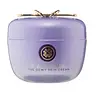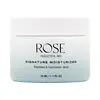What's inside
What's inside
 Key Ingredients
Key Ingredients

 Benefits
Benefits

 Concerns
Concerns

 Ingredients Side-by-side
Ingredients Side-by-side

Water
Skin ConditioningSaccharomyces/Rice Ferment Filtrate
Skin ConditioningGlycerin
HumectantPropanediol
SolventDimethicone
EmollientSqualane
EmollientDiisostearyl Malate
EmollientBehenyl Alcohol
EmollientMyristyl Myristate
EmollientDipentaerythrityl Hexahydroxystearate
EmulsifyingBis-Diglyceryl Polyacyladipate-2
EmollientTridecyl Trimellitate
EmollientInositol
HumectantSorbitan Tristearate
EmulsifyingBeheneth-20
EmulsifyingCamellia Sinensis Leaf Extract
AntimicrobialCladosiphon Okamuranus Extract
Skin ConditioningChondrus Crispus Extract
Skin ConditioningBetaphycus Gelatinum Extract
BleachingOryza Sativa Bran Extract
Skin ConditioningPanax Ginseng Root Extract
EmollientOriganum Majorana Leaf Extract
AntiseborrhoeicThymus Serpyllum Extract
Skin ConditioningMalva Sylvestris Flower Extract
Skin ConditioningSodium Hyaluronate
HumectantGold
Cosmetic ColorantSericin
Skin ConditioningPhytosteryl Macadamiate
Skin ConditioningTocopherol
AntioxidantHydroxyethyl Acrylate/Sodium Acryloyldimethyl Taurate Copolymer
Emulsion StabilisingSorbitan Isostearate
EmulsifyingPolysorbate 60
EmulsifyingButylene Glycol
HumectantDimethicone/Vinyl Dimethicone Crosspolymer
Skin ConditioningSodium Benzoate
MaskingGluconolactone
Skin ConditioningEthylhexylglycerin
Skin ConditioningParfum
MaskingAlcohol
AntimicrobialPhenoxyethanol
PreservativeCitral
PerfumingLimonene
PerfumingLinalool
PerfumingMica
Cosmetic ColorantTin Oxide
AbrasiveCI 77891
Cosmetic ColorantCI 60725
Cosmetic ColorantWater, Saccharomyces/Rice Ferment Filtrate, Glycerin, Propanediol, Dimethicone, Squalane, Diisostearyl Malate, Behenyl Alcohol, Myristyl Myristate, Dipentaerythrityl Hexahydroxystearate, Bis-Diglyceryl Polyacyladipate-2, Tridecyl Trimellitate, Inositol, Sorbitan Tristearate, Beheneth-20, Camellia Sinensis Leaf Extract, Cladosiphon Okamuranus Extract, Chondrus Crispus Extract, Betaphycus Gelatinum Extract, Oryza Sativa Bran Extract, Panax Ginseng Root Extract, Origanum Majorana Leaf Extract, Thymus Serpyllum Extract, Malva Sylvestris Flower Extract, Sodium Hyaluronate, Gold, Sericin, Phytosteryl Macadamiate, Tocopherol, Hydroxyethyl Acrylate/Sodium Acryloyldimethyl Taurate Copolymer, Sorbitan Isostearate, Polysorbate 60, Butylene Glycol, Dimethicone/Vinyl Dimethicone Crosspolymer, Sodium Benzoate, Gluconolactone, Ethylhexylglycerin, Parfum, Alcohol, Phenoxyethanol, Citral, Limonene, Linalool, Mica, Tin Oxide, CI 77891, CI 60725
Water
Skin ConditioningDimethicone
EmollientCaprylic/Capric Triglyceride
MaskingGlycerin
HumectantButyrospermum Parkii Butter
Skin ConditioningNiacinamide
SmoothingPentylene Glycol
Skin ConditioningCastanea Sativa Seed Extract
Skin ConditioningCetearyl Alcohol
EmollientHydroxyethyl Acrylate/Sodium Acryloyldimethyl Taurate Copolymer
Emulsion StabilisingSorbitan Stearate
EmulsifyingAscorbyl Glucoside
AntioxidantSodium Hyaluronate
HumectantCeramide NP
Skin ConditioningCeramide AP
Skin ConditioningCeramide EOP
Skin ConditioningTrehalose
HumectantPalmitoyl Tripeptide-1
Skin ConditioningPalmitoyl Tetrapeptide-7
Skin ConditioningCucumis Sativus Fruit Extract
EmollientVaccinium Myrtillus Fruit Extract
Skin ConditioningSaccharum Officinarum Extract
MoisturisingAcer Saccharum Extract
Skin ConditioningCitrus Aurantium Dulcis Fruit Extract
MaskingCitrus Limon Fruit Extract
MaskingLactic Acid
BufferingGlycolic Acid
BufferingCitric Acid
BufferingMalic Acid
BufferingTartaric Acid
BufferingGlyceryl Stearate
EmollientPEG-100 Stearate
Sodium PCA
HumectantTocopheryl Acetate
AntioxidantButylene Glycol
HumectantPhytosphingosine
Skin ConditioningCholesterol
EmollientSodium Lauroyl Lactylate
EmulsifyingSodium Citrate
BufferingCarbomer
Emulsion StabilisingXanthan Gum
EmulsifyingPolysorbate 20
EmulsifyingMica
Cosmetic ColorantTitanium Dioxide
Cosmetic ColorantCI 77491
Cosmetic ColorantTetrasodium Glutamate Diacetate
Sodium Hydroxide
BufferingPhenoxyethanol
PreservativeEthylhexylglycerin
Skin ConditioningWater, Dimethicone, Caprylic/Capric Triglyceride, Glycerin, Butyrospermum Parkii Butter, Niacinamide, Pentylene Glycol, Castanea Sativa Seed Extract, Cetearyl Alcohol, Hydroxyethyl Acrylate/Sodium Acryloyldimethyl Taurate Copolymer, Sorbitan Stearate, Ascorbyl Glucoside, Sodium Hyaluronate, Ceramide NP, Ceramide AP, Ceramide EOP, Trehalose, Palmitoyl Tripeptide-1, Palmitoyl Tetrapeptide-7, Cucumis Sativus Fruit Extract, Vaccinium Myrtillus Fruit Extract, Saccharum Officinarum Extract, Acer Saccharum Extract, Citrus Aurantium Dulcis Fruit Extract, Citrus Limon Fruit Extract, Lactic Acid, Glycolic Acid, Citric Acid, Malic Acid, Tartaric Acid, Glyceryl Stearate, PEG-100 Stearate, Sodium PCA, Tocopheryl Acetate, Butylene Glycol, Phytosphingosine, Cholesterol, Sodium Lauroyl Lactylate, Sodium Citrate, Carbomer, Xanthan Gum, Polysorbate 20, Mica, Titanium Dioxide, CI 77491, Tetrasodium Glutamate Diacetate, Sodium Hydroxide, Phenoxyethanol, Ethylhexylglycerin
 Reviews
Reviews

Ingredients Explained
These ingredients are found in both products.
Ingredients higher up in an ingredient list are typically present in a larger amount.
Butylene Glycol (or BG) is used within cosmetic products for a few different reasons:
Overall, Butylene Glycol is a safe and well-rounded ingredient that works well with other ingredients.
Though this ingredient works well with most skin types, some people with sensitive skin may experience a reaction such as allergic rashes, closed comedones, or itchiness.
Learn more about Butylene GlycolDimethicone is a type of synthetic silicone created from natural materials such as quartz.
What it does:
Dimethicone comes in different viscosities:
Depending on the viscosity, dimethicone has different properties.
Ingredients lists don't always show which type is used, so we recommend reaching out to the brand if you have questions about the viscosity.
This ingredient is unlikely to cause irritation because it does not get absorbed into skin. However, people with silicone allergies should be careful about using this ingredient.
Note: Dimethicone may contribute to pilling. This is because it is not oil or water soluble, so pilling may occur when layered with products. When mixed with heavy oils in a formula, the outcome is also quite greasy.
Learn more about DimethiconeEthylhexylglycerin (we can't pronounce this either) is commonly used as a preservative and skin softener. It is derived from glyceryl.
You might see Ethylhexylglycerin often paired with other preservatives such as phenoxyethanol. Ethylhexylglycerin has been found to increase the effectiveness of these other preservatives.
Glycerin is already naturally found in your skin. It helps moisturize and protect your skin.
A study from 2016 found glycerin to be more effective as a humectant than AHAs and hyaluronic acid.
As a humectant, it helps the skin stay hydrated by pulling moisture to your skin. The low molecular weight of glycerin allows it to pull moisture into the deeper layers of your skin.
Hydrated skin improves your skin barrier; Your skin barrier helps protect against irritants and bacteria.
Glycerin has also been found to have antimicrobial and antiviral properties. Due to these properties, glycerin is often used in wound and burn treatments.
In cosmetics, glycerin is usually derived from plants such as soybean or palm. However, it can also be sourced from animals, such as tallow or animal fat.
This ingredient is organic, colorless, odorless, and non-toxic.
Glycerin is the name for this ingredient in American English. British English uses Glycerol/Glycerine.
Learn more about GlycerinThis is a synthetic polymer. It helps improve the texture of products by adding thickness and gel-like feel.
It is also an emulsifer, meaning it prevents ingredients such as oil and water from separating. It also helps evenly disperse other ingredients.
Mica is a naturally occurring mineral used to add shimmer and color in cosmetics. It can also help improve the texture of a product or give it an opaque, white/silver color.
Serecite is the name for very fine but ragged grains of mica.
This ingredient is often coated with metal oxides like titanium dioxide. Trace amounts of heavy metals may be found in mica, but these metals are not harmful in our personal products.
Mica has been used since prehistoric times throughout the world. Ancient Egyptian, Indian, Greek, Roman, Aztec, and Chinese civilizations have used mica.
Learn more about MicaPhenoxyethanol is a preservative that has germicide, antimicrobial, and aromatic properties. Studies show that phenoxyethanol can prevent microbial growth. By itself, it has a scent that is similar to that of a rose.
It's often used in formulations along with Caprylyl Glycol to preserve the shelf life of products.
Sodium Hyaluronate is hyaluronic acid's salt form. It is commonly derived from the sodium salt of hyaluronic acid.
Like hyaluronic acid, it is great at holding water and acts as a humectant. This makes it a great skin hydrating ingredient.
Sodium Hyaluronate is naturally occurring in our bodies and is mostly found in eye fluid and joints.
These are some other common types of Hyaluronic Acid:
Learn more about Sodium HyaluronateWater. It's the most common cosmetic ingredient of all. You'll usually see it at the top of ingredient lists, meaning that it makes up the largest part of the product.
So why is it so popular? Water most often acts as a solvent - this means that it helps dissolve other ingredients into the formulation.
You'll also recognize water as that liquid we all need to stay alive. If you see this, drink a glass of water. Stay hydrated!
Learn more about Water